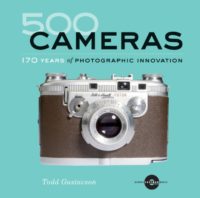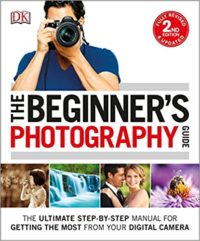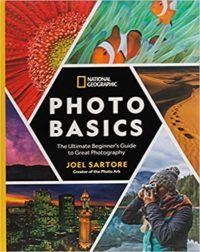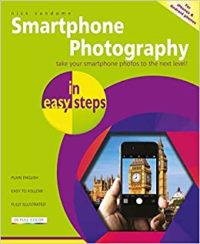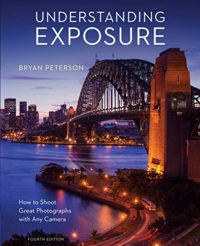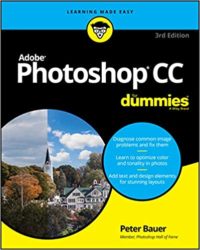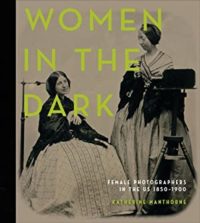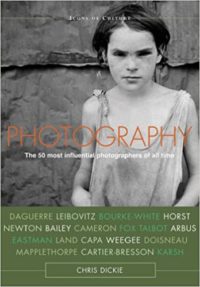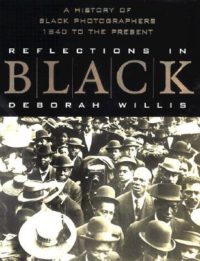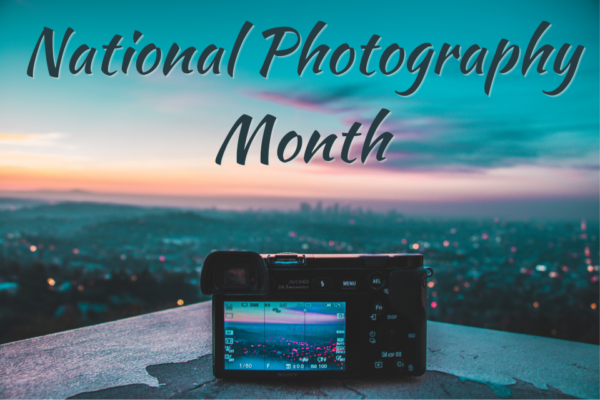
Everybody say “CHEEEESE” — it’s National Photography Month!
The word photography, derived from the Greek photos (meaning “light”) and graphein (meaning “to draw”), was first documented as far back as the 1830s. However, the term “camera” (originally referred to as “the camera obscura”) dates all the way back to around 500 BCE! (source: https://techtalk.currys.co.uk/infographics/dslr-camera-history/) With the passing of so much time, it’s safe to say photography has come a long way since then!
This month, join us as we celebrate our ability to capture and document special moments in our lives and share them with friends, family, and the wider community. If you are interested in learning more about photography, check out these books in our collection. Better snap them up before they’re gone!
History of Photography
Capturing the light: the birth of photography, a true story of genius and rivalry by Roger Watson
An intimate look at the journeys of two men–a gentleman scientist and a visionary artist–as they struggled to capture the world around them, and in the process invented modern photography. During the 1830s, in an atmosphere of intense scientific enquiry fostered by the industrial revolution, two quite different men–one in France, one in England–developed their own dramatically different photographic processes in total ignorance of each other’s work.
500 Cameras: 170 Years of Photographic Innovation by Todd Gustavson
Drawing upon the archives of the George Eastman House Collection, 500 Cameras takes a unique approach to the fascinating story of photography. Tracing the medium’s history through some of the most important equipment ever used by professionals and amateurs, this remarkable survey presents 500 cameras, all beautifully illustrated in spectacular images.
Instant: The Story of Polaroid by Christopher Bonanos
Instant photography at the push of a button!” During the 1960s and ’70s, Polaroid was the coolest technology company on earth. Like Apple, it was an innovation machine that cranked out one must-have product after another. Led by its own visionary genius founder, Edwin Land, Polaroid grew from a 1937 garage start-up into a billion-dollar pop-culture phenomenon. Instant tells the remarkable tale of Land’s one-of-a-kind invention-from Polaroid’s first instant camera to hit the market in 1948, to its meteoric rise in popularity and adoption by artists such as Ansel Adams, Andy Warhol, and Chuck Close, to the company’s dramatic decline into bankruptcy in the late ’90s and its unlikely resurrection in the digital age. Instant is both an inspiring tale of American ingenuity and a cautionary business tale about the perils of companies that lose their creative edge.
Grab Your Cameras
The Beginners Photography Guide by Chris Gatcum
Presents step-by-step digital SLR camera basics, while introducing and demonstrating a wide variety of techniques.
Digital Photography Complete Course by David Taylor
This book helps you to build your photography skills week-by-week. The Digital Photography Complete Course is the perfect one-on-one learning programme for any aspiring photographer. This modular 20-week course guides you through every aspect of digital photography, using a combination of tutorials, step-by-step photo shoots, practical assignments and fun Q&As. Demystify digital photography and build your photography skills with comprehensive guides on everything you need to know, from conveying movement and using natural light, to understanding exposure and mastering composition. This book will help you to understand and use your camera to its full potential so that you don’t just take good pictures – you take great ones.
National Geographic Photo Basics: The Ultimate Beginner’s Guide to Great Photography by Joel Sartore
For digital camera and smartphone users, this easy how-to guide, written by an experienced National Geographic photographer, imparts the essentials of taking great pictures..
Smartphone photography in easy steps: covers iphones and Android phones by Nick Vandome
Smartphone cameras have evolved from being useful for taking quick snapshots, to being powerful and sophisticated devices that, for many people, have replaced the need to use a separate camera. It is now possible to take high-quality photos, edit them and then share them in a variety of ways, all from your smartphone. Looks at all aspects of using your smartphone or tablet as a one-stop shop for all of your photographic needs.
Setting up the Perfect Shot
Understanding Exposure: How To Shoot Great Photographs with any Camera by Bryan Peterson
Veteran photographer Bryan Peterson demystifies complex concepts of exposure in photography by explaining the fundamentals of light, aperture, shutter speed, and how they interact with and influence one another. This book explains how to get or lose sharpness and contrast in images, freeze in action, and take the best meter readings while also exploring filters, flash, and light. This forth edition includes all new images as well as an expanded section on flash, tips for using colored gels, and advice on shooting star trails.
Fundamentals of Photo Composition by Paul Comon
The Photographer’s mind: creative thinking for better digital photos by Michael Freeman
Explains “what makes a photograph great, and explores the ways that top photographers achieve this good time and time again.
The Magic of Editing
Adobe Photoshop CC by Pete Bauer
This book helps you gain an understanding of Photoshop CC and take charge of the tools, menu commands, and shortcuts that will help you perfect your photos and designs.
Photoshop Elements tips, tricks & shortcuts in easy steps for Windows and Mac by Nick Vandome
2020 Photoshop Elements Tips, Tricks and Shortcuts in easy steps not only offers a comprehensive guide to getting up and running with the software, but goes further: providing a wealth of detail in ways to progress to more advanced photo-editing and also find some of the hidden secrets of the software. Although the book looks at some of the ways you can expand your photo-editing exploits, it does not forget new users or anyone who wants to brush up on the basics. Photoshop Elements Tips, Tricks and Shortcuts in easy steps covers versions for both PC and Mac users, and has something for everyone: an in depth introduction for new users, and a range of options for those who want to take their photo-editing to the next level. Throughout, there are hundreds of tips and handy hints so that the reader will feel like an Elements expert in no time.
GIMP 2.8 for photographers: image editing with open sources software by Klaus Goelker
Image editing is a crucial element in the photographic workflow. Image editing tools, most notably Photoshop, are usually sophisticated and deep applications, and are fairly expensive. The only open source tool in this market is the GIMP, which has developed into a powerful, multiplatform system running on Linux, Mac OS X, and Microsoft Windows. GIMP 2.8 for Photographers is a beginner’s guide to the only open source image editing tool that provides a no-cost alternative to expensive programs such as Photoshop. Topics include the new user interface and tools, the basics of image editing and simple adjustments, advanced techniques using layers and masks, developing RAW images, working with the improved text tool, and preparing high-quality black-and-white images. The most important editing functions are presented in individual, easy-to-follow workshops. A bonus section on the included DVD describes special techniques for web graphics. GIMP 2.8 for Photographers has evolved from classroom materials that the author developed and taught in courses and workshops on image editing with the GIMP
The Magic of Editing
Adobe Photoshop CC by Pete Bauer
This book helps you gain an understanding of Photoshop CC and take charge of the tools, menu commands, and shortcuts that will help you perfect your photos and designs.
Photoshop Elements tips, tricks & shortcuts in easy steps for Windows and Mac by Nick Vandome
2020 Photoshop Elements Tips, Tricks and Shortcuts in easy steps not only offers a comprehensive guide to getting up and running with the software, but goes further: providing a wealth of detail in ways to progress to more advanced photo-editing and also find some of the hidden secrets of the software. Although the book looks at some of the ways you can expand your photo-editing exploits, it does not forget new users or anyone who wants to brush up on the basics. Photoshop Elements Tips, Tricks and Shortcuts in easy steps covers versions for both PC and Mac users, and has something for everyone: an in depth introduction for new users, and a range of options for those who want to take their photo-editing to the next level. Throughout, there are hundreds of tips and handy hints so that the reader will feel like an Elements expert in no time.
GIMP 2.8 for photographers: image editing with open sources software by Klaus Goelker
Image editing is a crucial element in the photographic workflow. Image editing tools, most notably Photoshop, are usually sophisticated and deep applications, and are fairly expensive. The only open source tool in this market is the GIMP, which has developed into a powerful, multiplatform system running on Linux, Mac OS X, and Microsoft Windows. GIMP 2.8 for Photographers is a beginner’s guide to the only open source image editing tool that provides a no-cost alternative to expensive programs such as Photoshop. Topics include the new user interface and tools, the basics of image editing and simple adjustments, advanced techniques using layers and masks, developing RAW images, working with the improved text tool, and preparing high-quality black-and-white images. The most important editing functions are presented in individual, easy-to-follow workshops. A bonus section on the included DVD describes special techniques for web graphics. GIMP 2.8 for Photographers has evolved from classroom materials that the author developed and taught in courses and workshops on image editing with the GIMP
Learn From The Professionals
Women in the dark : female photographers in the US, 1850-1900 by Katherine Manthorne
Recover the stories of long-overlooked American women who, at a time when women rarely worked outside the home, became commercial photographers and shaped the new, challenging medium. Covering two generations of photographers ranging from New York City to California’s mining districts, this study goes beyond a broad survey and explores individual careers through primary sources and new materials. Profiles of the photographers animate their careers by exploring how they began, the details of running their own studios, and their visual output. The featured photos vary in form–daguerreotype, tintype, carte de visite, and more–and subject, including Civil War portraits, postmortem photography, and landscape photography. This welcome resource fills in gaps in photographic, American, and women’s history and convincingly lays out the parallels between the growth of photography as an available medium and the late-19th-century women’s movement.
Photography: 50 Most Influential Photographers of all time by Chris Dickie
Reflections in Black: a history of black photographers, 1840 to the present by Deborah Willis
Shows that the history of black photographers intertwines with the story of African American life, as seen through photographs ranging from antebellum weddings and 1960s protest marches, to portraits of contemporary black celebrities.
The Negative by Ansel Adams
Pilgrimage by Annie Leibovitz
Pilgrimage took Annie Leibovitz to places that she could explore with no agenda. She wasn’t on assignment. She chose the subjects simply because they meant something to her. The first place was Emily Dickinson’s house in Amherst, Massachusetts, which Leibovitz visited with a small digital camera. A few months later, she went with her three young children to Niagara Falls.
Additional Resources
There’s also lots of valuable websites out there for photography enthusiasts that offer free tutorials, equipment reviews, news articles, community forums, and of course, tons of inspiration!


